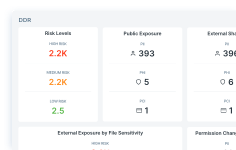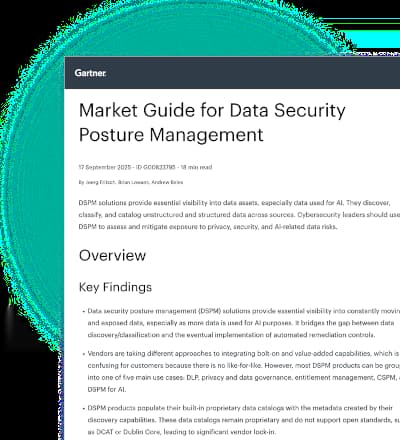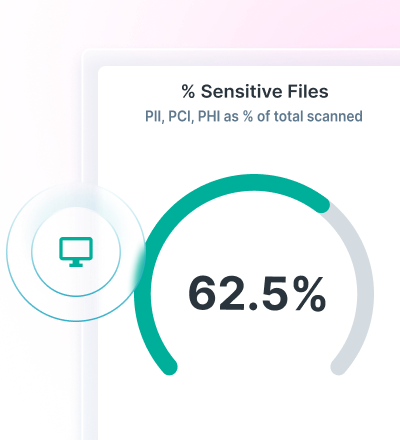Demystifying Data Security Posture Management: Why Visibility and Remediation Matter
0 min read

Lionel Menchaca
Organizations largely run on data that lives everywhere: inside SaaS apps, cloud data, developer sandboxes, endpoint caches and AI workflows. The more distributed your data, the harder it is to answer these questions with confidence. Where is your sensitive data? Who can touch it? What is it doing right now?
Addressing challenges related to those questions is the essence of data security posture management (DSPM). DSPM gives security and risk teams visibility into where sensitive data resides, how it is classified, which controls protect it and what to do when something looks risky. It turns posture from a periodic audit exercise into a living program that guides decisions every day.
This guide breaks down the core of data security posture management and how modern capabilities go beyond legacy data protection.
What is Data Security Posture Management?
DSPM is a security solution that enables enterprises to discover and classify data across file storage locations, such as cloud applications or on-premises. It also helps to proactively address incident remediation. The benefits of Data Security Posture Management can boil down to four outcomes:
- Increase productivity
- Cut costs
- Reduce risk
- Streamline compliance
DSPM matters because the surface area for data risk has outgrown point tools and manual audits. Data sprawl and shadow IT create blind spots. Access rights grow faster than governance. Misconfigurations turn private information public.
Regulators now expect demonstrable control. And AI adoption adds new channels where sensitive data can leak through prompts, agents and integrations. DSPM helps close that gap.
Why Now is the Turning Point
The last few years have reshaped the data landscape. Developers build in cloud-native stacks. Businesses consolidate and modernize analytics. And teams adopt hundreds of SaaS tools that create and copy data.
Meanwhile, attackers pivot from simple malware to campaigns that exploit identity, misconfigurations and exposed storage. This results in more opportunities for sensitive information to be overshared, overexposed or outright attacked.
DSPM changes the landscape. Instead of reactive, event-by-event triage, teams can operate with a current map of sensitive data, who uses it and whether controls match policy. That foundation makes every downstream function better.
Inside Forcepoint Data Security Posture Management (DSPM)
Forcepoint DSPM is built for organizations that want a proactive solution for data security and compliance. Read on for core capabilities and features of Forcepoint DSPM.
AI Mesh: Data Classification with Artificial Intelligence
Forcepoint DSPM software scans any data source and uses proprietary AI Mesh technology to identify, categorize and remediate high-risk data.
AI Mesh is a highly networked classification architecture that uses a Small Language Model (SLM), deep neural network classifiers, light AI classifiers and other predictive AI and data science capabilities to deliver more rapid, accurate and efficient data classification.
The SLM helps set in motion the AI-powered classification process, determining a piece of data’s sensitivity and criticality based on contextual criteria.
SLMs are nimbler and more efficient than LLMs, providing low-latency capabilities at a fraction of the resources their larger counterparts require. These models are highly customizable and when used within the AI mesh, deliver lightning-fast data classification with bull’s-eye accuracy.
Remediation Wired into DSPM
Actionable insights enable you to manage permissions, move misplaced data and address data sovereignty, access and duplicate or ROT data issues.
Automate Compliance Management
Forcepoint DSPM helps simplify compliance processes to support alignment with evolving regulations, reducing manual effort.
Improve Data Visibility and Proactively Remediate Risk
Forcepoint DSPM helps gain complete visibility into data across both cloud and on-premises environment to track and manage sensitive data wherever it resides.
It also provides actionable insights that enable you to manage permissions, move misplaced data and address data sovereignty, access and duplicate or ROT data issues.
Benefits of DSPM
Increase Productivity
Forcepoint DSPM automates data discovery and classification using AI and machine learning. This eliminates manual processes that can be slow and error prone. And secure data posture in order for the organization to be more agile, increasing total productivity.
Cut Costs
Accelerate overall business to freely move without concern of risky data posture resulting in top and bottom-line gains.
Reduce Risk
Reduce risk of data (ROT, duplicates, data sovereignty, etc.), ensure principle of least privilege (PoLP) is maintained, and reduce potential for risk of data breaches through posture management.
Streamline Compliance
Forcepoint DSPM generates reports that demonstrate your compliance with data privacy regulations, saving you time and resources during audits. By providing a centralized view of your data, Forcepoint DSPM makes it ultimately easier to implement and enforce data governance policies.
How DSPM Relates to Other Tools
Data security posture management complements, not replaces, existing controls. Clear boundaries help teams design the right coverage.
- DSPM vs DLP: DLP stops exfiltration in motion and at rest. DSPM maps sensitive data and its controls. Together, posture informs prevention.
- DSPM vs CSPM and KSPM: Cloud and Kubernetes posture tools focus on infrastructure and configuration baselines. DSPM focuses on the data itself: its locations, classifications, access and movement. Both are essential to eliminate attack paths.
- DSPM and DDR: DDR spots threats and suspicious behaviors. DSPM supplies the data context that turns a generic signal into an actionable incident with clear business impact.
Best Practices for a Successful DSPM Program
Start with a clear scope and stakeholders
Define what “sensitive” means in your context. Bring in data owners, legal, compliance and security operations. Assign decision rights early so posture findings become action, not debate.
Build a trustworthy inventory first
Run broad discovery to create your baseline. Prioritize high-value systems and common shadow channels like collaboration shares and object storage. Label owners for each dataset so fixes have a destination.
Tune classification with your business language
Out-of-the-box classifiers are a starting point. Use AI Mesh tuning and custom patterns to recognize your unique data: proprietary formulas, code modules, deal templates, design artifacts. Involve subject-matter experts to validate and improve accuracy.
Align policy to how the business works
Write policies people can follow. Define allowed locations for specific data types, retention rules and access models. Map these to technical controls so enforcement is consistent in every system.
Decide when to automate and when to approve
Not every action should be automatic. Use risk-based thresholds. For clear-cut cases, automate quarantine or encryption. For high-impact changes, route to data owners with one-click approvals and clear context.
Connect DSPM to daily operations
Wire posture findings into ticketing, chat, SIEM and SOAR. Give responders the data context at alert time. Provide owners with simple, targeted tasks. Make it easy to do the right thing fast.
Measure progress and show value
Track trends like reduced public exposure, fewer overshared folders and faster incident resolution. Report on policy coverage for key data types. Celebrate risk eliminated, not just alerts closed.
The Forcepoint Difference
Forcepoint DSPM was built for real-world data protection.
If your team is being asked to adopt AI safely, reduce audit stress and eliminate blind spots, you need a posture program that keeps up. Forcepoint DSPM provides complete visibility into data across both cloud and on-premises environment to track and manage sensitive data wherever it resides.
Getting Started
Begin with what matters most: identify your high-value data and where it lives today. Deploy discovery, validate classification with your experts and align policy to the realities of your business. Posture improves every time a control is corrected, an exception is closed and an exposure is prevented.
Forcepoint is ready to help you see your data clearly, secure it precisely and respond with confidence. Explore more about Forcepoint DSPM today.
If you want to see how DSPM can benefit your organization directly, sign up for a free Data Risk Assessment from Forcepoint. Here's a short video overview of what it entails:

Lionel Menchaca
Read more articles by Lionel MenchacaAs the Content Marketing and Technical Writing Specialist, Lionel leads Forcepoint's blogging efforts. He's responsible for the company's global editorial strategy and is part of a core team responsible for content strategy and execution on behalf of the company.
Before Forcepoint, Lionel founded and ran Dell's blogging and social media efforts for seven years. He has a degree from the University of Texas at Austin in Archaeological Studies.
 Executive Guide to DSPM: Visibility and Control over Sensitive DataRead the eBook
Executive Guide to DSPM: Visibility and Control over Sensitive DataRead the eBook
X-Labs
Get insight, analysis & news straight to your inbox

To the Point
Cybersecurity
A Podcast covering latest trends and topics in the world of cybersecurity
Listen Now









